
 US Navy Landing Craft (1938-45): 500 LCM(1), 8,631 LCM(3), 2,513 LCM(6). Operated 1943-1945
US Navy Landing Craft (1938-45): 500 LCM(1), 8,631 LCM(3), 2,513 LCM(6). Operated 1943-1945
D-Day Special ! The Landing Craft Mechanized (LCM) was the third major Allied Landing Craft type, mixing troops, tanks and vehicles or payloads depending on the need. The type was developed by the British, and became the basis for modern Landing Crafts and in particular to the LCU. The denomination LCM remained active however until recent days. In WW2 they took part in all major amphibious operations. The US developed two types, the LCM(3) and LCM(6) and the British the LCM(1), 2, 4, 5, and 7. They were generally carried by assault ships. The USN ordered a replacement in 1959, too late for Korea, but right in time for the Vietnam war, called the LCM-8. Modernized and largely exported they saw acton in the 1991 gulf war and 2003 invasion of Iraq as well, and are still active.
Origin and Development
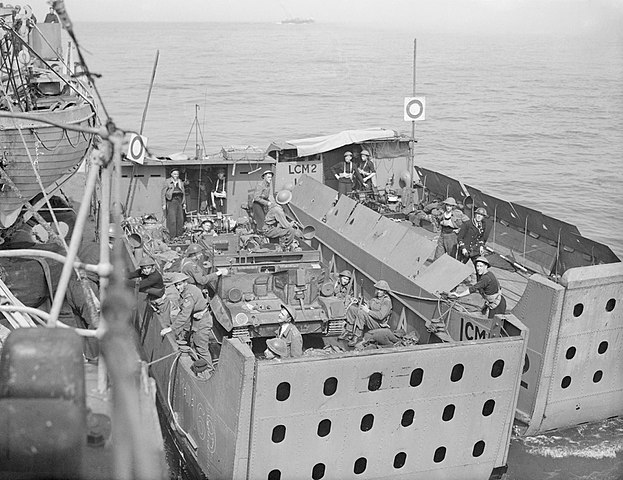
LCM(1), Dieppe Raid, August 1942
Ancestor: The Motor Landing Craft
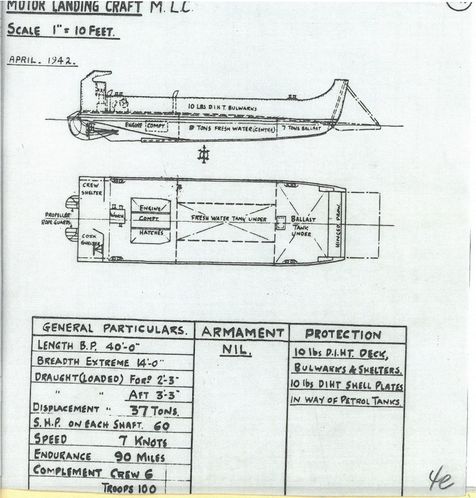
The roots of the LCM concept can be found in a the earlier MLC. The need for a purpose-built landing craft was apparent since the Gallipoli Campaign in WW1, but neither Army or Royal Navy ever agreed on who should fund such construction. A bi-service landing craft committee comprising representatives of of both was created to gather recommendations on the design. The Director of Naval Construction was requested to draw up a design from these specifications, but the post-war crisis stalled the project in 1924. It’s only in 1926 that the funding of a prototype motor landing craft (MLC1) was obtained, and the craft was tested later that year and completed trials in 1927.
This 16 tons vessel had a draught of 6.5 ft (2 m) and was box-like with a square bow and stern, and showed to be extremely noisy. Instead of propellers, that could be fouled when beached, it had instead an engenious waterjet propulsion system from White’s designers. The engine was a Hotchkiss petrol, driving a centrifugal pump with the pressure going into high pressure smaller cone and create a jet pushing the craft ahead or astern and also able to steering the craft as it could be directed at a 5-6 knots speed. Beaching capacity was judged excellent at the time and after tweaks in the design interrupted by the 1929 crisis, in 1930, three more MLC were accepted in the Royal Navy.
Early MLCs had a single Hotchkiss petrol engine until replace further down in production by a single Gill petrol engine.
It seems only nine, more the initial prototype, were available for operations when WW2 broke out, six based in Britain and three in Malta.
The first test was the Norwegian Campaign in 29 April 1940, as three MLCs were part in a small flotilla with a Landing Craft Mechanised Mk 1 (LCM) Mark I and four Landing Craft Assault (LCA)s for the assault on Narvik. Two more MLCs joined them for transfer. In early May, one MLC was shown capable to bring on shore French 75mm guns to support the French Chasseurs at Gratangen.
At Hol on 11 May, one sank due to a loading accident, trying to carry a 13-ton Hotchkiss H39 tank. It drove off a jetty directly into the cargo well, puncturing it, creating a loss of buoyancy and both sank to the bottom.
Others MLCs landed French Foreign Legionnaires of the 13th Demi-Brigade (13e DBLE) and one landed a French Hotchkiss H39 at Bjerkvik, just 8 miles (13 km) above Narvik on 13 May. Brigadier General Antoine Béthouart which captured later the area north of Rombaksfjorden behind German lines in Herjangsfjorden and force them to retire parised the landing craft as a key asset. The following day was a pre-landing naval bombardment, then landing of three tanks, two from MLCs, one from an LCM(1), and a first wave of infantry from LCAs, then reinforcements on barges towed by MTBs. On 12 May at 23:40, destroyers started shelling the town but the slow deployment of the MLCs from davits on the battleship Resolution frustrated operations and caused delays. All MLCs of the Narvik landing were lost in operations due to the elements or abandoned as the Allied withdrew.
Next, two MTLs took part in Operation Dynamo, evacuating BEF personal off the beaches, east of Dunkirk, again with an LCM(1) and LCAs. MLC12 (yes, the number is superior to the production run) was abandoned at Dunkirk on 2 June, as well as MLC17 later.
⚙ MLC class specs. |
|
| Displacement | 16t light, 20 long tons (20,321 kg) |
| Dimensions | 40 x 14 x 4.5 ft (12.2 x 4.3 x 1.4 m) |
| Propulsion | Hotchkiss/Gill petrol, waterjet |
| Speed | 5–6 knots (9.3–11.1 km/h; 5.8–6.9 mph) |
| Range | Unknown |
| Protection | None 1926 proto, 1936 prod. steering shelter 0.5 mm steel |
| Capacity | 10 long tons payload or 1x 13t tank or 80 troops |
| Crew | |
Concept of the LCM
Like many amphibious vessels from 1937, carrying troops (a platoon typically) and a light tank for support, make it attractive to planners. The landing craft was to be slung under the davits of a liner or converted cargo ship boom. This configuration however put a strain on the structure and limited its payload to a 16-ton tank, which was the equivalent of a M3/M5 light tank Stuart. Of 600 built from 1938 (prototype, then in 1940-45), the LCM Mark I saw action alreay in April 1940, with the Allied landings in Norway alongside the MLCs and much later at Dieppe in August 1942. They were superseded by better models quickly. Indeed, until then, tests with the MLCs showed many avenues of improvement: A more discreet engine, better speed, and greater capacity.
The design was to marry opposite qualities, being at the same time a good sea boat while being suitable for beaching.
Since the inter-service commission that created the MLC had been disbanded, a new one was created, the ISTDC, in May 1938. It was active until mid-1942 (when replaced by Louis Mountbatten and the Chief of Combined Operations (CCO)). It developed among others paratrooper gear and delivery methods, air supply, beach organization and floating piers as well as HQ ships and amphibious tanks, underwater obstacles and small commando craft.
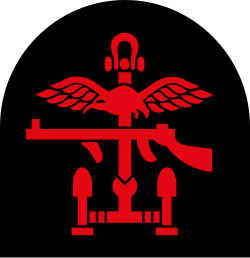 The Inter-Service Training and Development Centre was a department under the British Chiefs of Staff to develop methods and equipment for Combined Operations and under the Combined Operations Headquarters in June 1940. It was composed of representatives from the Royal Navy, Army, and RAF. The landing crafts developed were the LCA (infantry) close support (LCS) and concentrated on a landing craft than can land a tank on the beach. A delegation studies the heaviest tanks that might be employed in a landing (likely the 11-ton Matilda I, designed specifically for infantry support, but soon they turned their attention to the Matilda II in development since 1937 (25t). It soon apeared however the latter was way too heavy to have any chance that the carrier would be slung under davits.
The Inter-Service Training and Development Centre was a department under the British Chiefs of Staff to develop methods and equipment for Combined Operations and under the Combined Operations Headquarters in June 1940. It was composed of representatives from the Royal Navy, Army, and RAF. The landing crafts developed were the LCA (infantry) close support (LCS) and concentrated on a landing craft than can land a tank on the beach. A delegation studies the heaviest tanks that might be employed in a landing (likely the 11-ton Matilda I, designed specifically for infantry support, but soon they turned their attention to the Matilda II in development since 1937 (25t). It soon apeared however the latter was way too heavy to have any chance that the carrier would be slung under davits.
The army wanted to be able to land a 12-ton class tank, so closer to a Matilda I or the lighter Mark VI light tank, but the ISTDC anticipated weight increases and future tank, raising the bar to a 16 tons burthen for any Mechanised Landing Craft.
The Mercantile Marine Department of the Board of Trade then reported to the ISTDC that for this craft to be carried on ordinary heavy-derrick merchant ships it was not to be above 20 tons and 40 feet in length for 14 feet in beam. It was understood by the Army that the new LCM also was to be capable of landing tanks but also other vehicles, in less than 2 ½ feet of water to avoid bogging down in wet sand, especially for wheeled vehicles. Design work started when Thornycroft was selected in May 1938. The builder was indeed the best suited for that clas sof light crafts. Design, then construction, early tests, fixes went on in 1939, and trials at sea for the prototype were completing in February 1940, now with more emergency.

Base schematic for the LCM(1)
The RN then greenlighted the type after last minute adjustments, as the LCM(1) Or “Landing Craft Mechanized, Mark 1”. It was naturally powered by two in-house Thornycroft 60 bhp petrol engines, but only for the first batch, as it appeared than the factory could just not provide the numbers. The design was altered after the Chrysler in-line 6-cylinder Crown petrol engine was selected in the US by the British purchase commission via lend-lease. Each developedg 60 bhp at 3,200rpm. Later it was improved and able to generate an output of 115 bhp also at 3200 rpm. Piston displacement for the 60 bhp engine was 250.6 cubic inches.
Two sets of vents were installed port and starboard to force air into the engine space. On eof the engine was located immediately to the fore of the wheel house, the second about 1/3 over her overall length from the stern. They were combined on a single gearbox, but acted on two shafts for better agility. The latter had three bladed propellers protected by sets of guard-bars, also protecting the rudders aft. The core concept was to be able to beach, gap the space still underwater by a ramp, which also acted as wave-guard, with a lower section designed to cut wave, and the chin rounded to tranistion to the flat-bottom. More LCMs will follow.
British LCMs
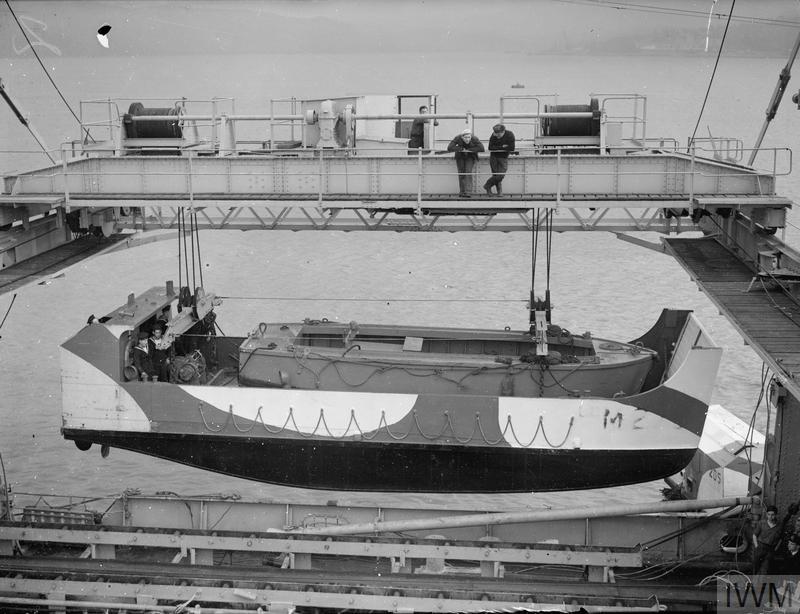
In alternative to a M3 Stuart tank plus 100 troops, the LCM(1) wcould carry a standard 3-tonnes lorry or two jeeps, and troops. Three main variants were built, in UK and in the US, transferred via lend-lease, in all 750 British-built and and 650 US-built so 1,400 in all. There were three versions produced over the years.
 LCM(1) (1940)
LCM(1) (1940)

LCM(1) during the Dieppe Raid.
This was a 36 tonnes, 48.5 feets overall boat with high walls and a ramp. The driver and engine compartments were at the rear. The Landing Craft, Mechanised Mark 1 had a covered cabin at the rear which maked it recoignisable and well adapted to the north European climate, and walls ending with a curved bow framing the ramp. The latter was pierced by openings to make it lighter. It made also improvized portholes for firing but made the deck wet in heavy weather. In standard, it could carry up to 100 equipped infantrymen or three platoons. Production went on until 1944 and 132 were still listed operational by mid-1945, so about 1/5 of the total.
The first were allocated to the 601 LCM Flotilla and among the 500 British built Mark 1s most came from the Great Western Railway at Swindon in Wiltshire, with the remainder from the Southern Railways workshops at Eastleigh in Hampshire. Others, and parts, were also dlivered by metal-working establishments in 1940-1944.
Top speed was 10 knots (light) down to 6 knots (loaded), with a range of 50–80 miles. The crew consisted in six men, the coxswain, stoker, four seamen, and one officer per group of three boats. Armament was light, only two Lewis Guns and armour comprised DIHT steel plating, (3/4″ or 1/4″) depending on the location.
First use in action was in Norway, alongside older PLCs, where a LCM(1) carried to shore a French 13-ton Hotchkiss H39 supporting the 13th Demi-Brigade (13e DBLE) on the beach at Bjerkvik, near Navrik. later General Antoine Béthouart directed another raid behind German lines using these boats. The capacity of carrying light tank proved instrumental in allied success in this operation, by combining LCM, MLCs, and LCAs. Later one LCM was also used at Dunkirk. These were used mostly for commando operations, in North Africa and Indian Ocean as well, used by RCN and RIN troops. The US army depended also on these crafts in their early landings (Operation Torch and following).
⚙ LCM(1) specifications |
|
| Displacement | 21 long tons (21,337 kg) |
| Dimensions | 48.5 x 14 x c3ft (14.8 x 4.3 x 1m) |
| Propulsion | 2× 60 bhp Thornycroft petrol (later Chrysler) |
| Speed | 10 kt (light), 6 kt (loaded) |
| Range | 50–80 miles |
| Armament | 2 × Lewis Guns |
| Protection | 10lb. DIHT (3/4″) bulkheads and sides, 7.8 lb. DIHT (1/4″). |
| Capacity | 1x 16t tank/100 troops |
| Crew | 6 |
 LCM(1) Variant: The LCM(4)
LCM(1) Variant: The LCM(4)
The LCM(4) was developed in 1943-1944, with seventy-seven (77) built. Completely identical, but only the pontoon diverged by having special bilge pumps and ballast tanks to alter trim and increase stability when partially loaded.
 LCM(3)
LCM(3)
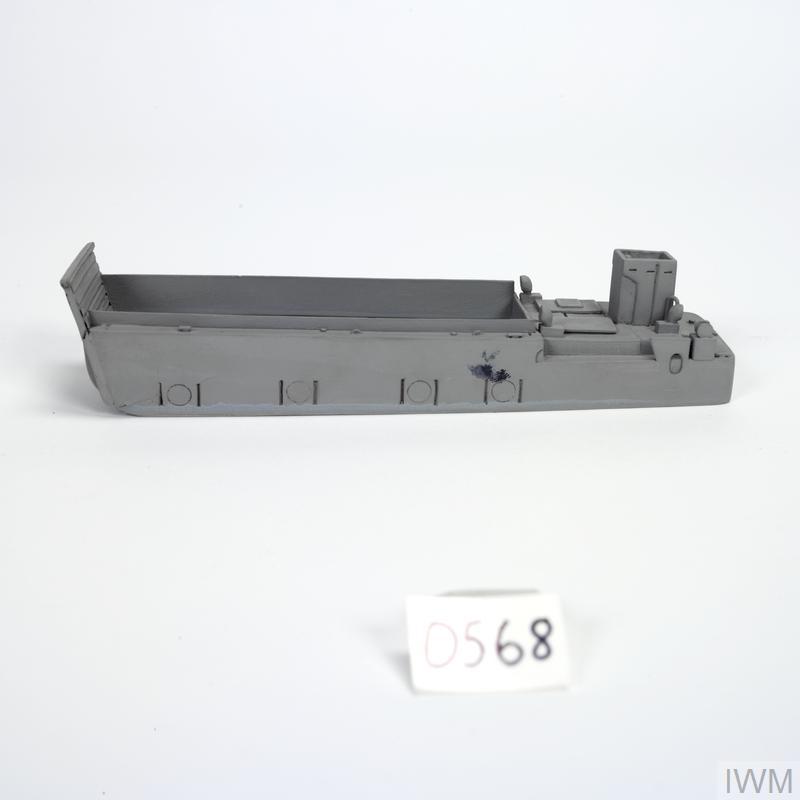
The Landing Ship, Mechanized, Mark III was not an evolution of the Mark I but the American version of the latter. In all 650 US-built were transferred via lend-lease.
Specifications
-Dimensions: Length: 50 feets, Displacement: 52 tonnes full, 22 light.
-Crew of four: 1 coxwain, 1 engineer, 2 crew members.
-Propulsion: 2 Diesel engines, 110-225 hp Top speed 11 knots, 8 knots loaded
-Transport capacity: 30-ton tank, 60 equipped soldiers.
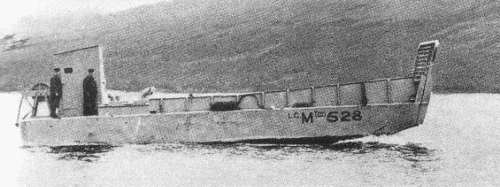
LCM(3) on trials, LCM 528 (MoD)
⚙ LCM(3) specifications |
|
| Displacement | 25 tons FL |
| Dimensions | 15,25 m long overall |
| Propulsion | 2 Diesel engines, 110-225 hp |
| Speed | 8 knots FL, 11 knots unladen |
| Armament | |
| Capacity | 30-ton tank or 60 equipped soldiers |
| Protection | 0.25 in steel plating |
| Crew | 4: coxwain, engineer, 2 crew members |
 LCM(7)
LCM(7)
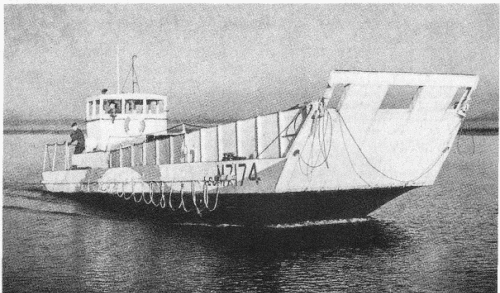
LCM(7) M7174 (MoD)
The largest of all, 60 feets long overall. Same arrangement as the former, with a small cabin at the rear.
It was reinforced and large enough to carry a single 40 tonnes tank such as the Sherman M4. US-built but a small number, 150, were British-built in 1943-44.
⚙ LCM(7) specifications |
|
| Displacement | 28 tonnes light, 63 tonnes full. |
| Dimensions | 18.4m x 4.90m x 1.13m (60 feets long) |
| Propulsion | 2 shafts Hudson Invader diesels, 290 bhp, 11 knots, 1.7 tonnes fuel oil, 150 nm. |
| Armament | 2x 12.7 mm .5 cal Browning M2HB |
| Capacity | 1x 35/40t tank/100 troops |
| Crew | 7 |
US LCMs
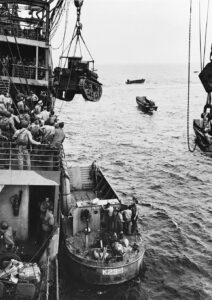 The development of the LCM started in the 1930s already when the USMC looked at a better way to land troops with heavier equipment than the usual methods of boats with a landing party, just coming from a cruiser or capital ship. Ideally, the idea was to provide the USMC with a tankette like the 1918 Ford 3-ton, that could provide the necessary support. There was even a beach assault procedure that was established, counting on a purpose built craft for the initial assault wave, followed by boats and cutters, and purpose built tank lighter for vehicles as well as artillery and supplies. But the financial crisis and lack of funding, plus Navy restrictions on such craft stalled this development, at least until war returned in Europe. By 1940 at least funding was there and the USMC could obtained the construction of a prototypes of 38-foot, 39 and 40-foot long vessels. Tests were positive and by September 1940, the USMC sent their final requirements for a tank landing craft, submitted to the Bureau of Construction and Repair (BuC&r). This led to a 45-foot lighter that can accomodate the 15 ton Army model tank (M2, then M3 light tank). The final production model was the LCM (2), known under Marine Corps designation YL. Vignette: M2A4 Stuart loaded into a LCM(2) from USS Alchiba (AK-23) off Guadalcanal on 7 August 1942.
The development of the LCM started in the 1930s already when the USMC looked at a better way to land troops with heavier equipment than the usual methods of boats with a landing party, just coming from a cruiser or capital ship. Ideally, the idea was to provide the USMC with a tankette like the 1918 Ford 3-ton, that could provide the necessary support. There was even a beach assault procedure that was established, counting on a purpose built craft for the initial assault wave, followed by boats and cutters, and purpose built tank lighter for vehicles as well as artillery and supplies. But the financial crisis and lack of funding, plus Navy restrictions on such craft stalled this development, at least until war returned in Europe. By 1940 at least funding was there and the USMC could obtained the construction of a prototypes of 38-foot, 39 and 40-foot long vessels. Tests were positive and by September 1940, the USMC sent their final requirements for a tank landing craft, submitted to the Bureau of Construction and Repair (BuC&r). This led to a 45-foot lighter that can accomodate the 15 ton Army model tank (M2, then M3 light tank). The final production model was the LCM (2), known under Marine Corps designation YL. Vignette: M2A4 Stuart loaded into a LCM(2) from USS Alchiba (AK-23) off Guadalcanal on 7 August 1942.
 LCM(2) (1941)
LCM(2) (1941)
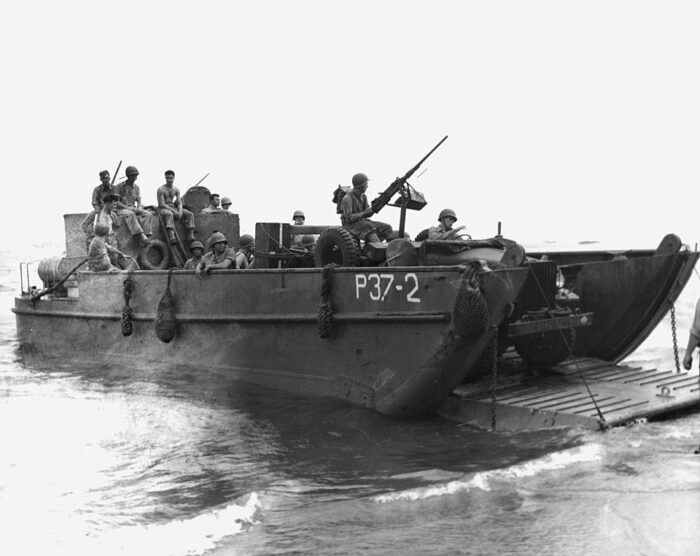
LCM-2 from USS Pdt. Jackson (AP-37) landing at Guadalcanal, August 1942.
This was the first American LCM design, inspired by the British LCM Mark I, from the US Navy’s Bureau of Construction and Repair. 150 were built by American Car & Foundry and Higgins Industries. They first saw action at Guadalcanal, where 48 LCM (2)s out of the 147 ever manufactured were deployed. This was completed by a force of 113 LCVs, and the same LCM(2) multiplied ritations to bring everything to shore. In Next November, they were operated by Western Task Force. Later in July 1942, they were mobilized for Operation Husky in Sicily and they saw action last for the Salerno Landongs by September 1943. They had been superseded by the LCM(6) by this point.
Specs LCM(2)
Displacement: 29 tons light
Dimensions: 45 ft x 14 ft 1 in x 3 ft (14 x 4.3 x 0.91 m)
Engine: 2x Kermath petrol, 225 hp (168 kW)
Speed: 7.5 knots (13.9 km/h)
Armament: 2x .50-cal M2 Browning machine guns
Crew: 4
Protection: 1/4 in plating, fwd control station
Capacity: 100 troops, or one 14 ton tank, or 14 tons of cargo
 LCM(3) (1941)
LCM(3) (1941)
8,631 vessels built by Higgins Industries.

Higgins LCM-3 at Battleship Cove
Landing Ship, Mechanized (Mark 3)
In December 1941, the admiralty decided every landing should be covered by a medium, rather than a light tank. A 50 feet design was ordered.
There were two designs: The Bureau of Ship’s one was capable of carrying 120,000 lb (54,000 kg) of cargo. The private Higgins one was in appearance very similar to Higgin’s LCVP but with a 10-foot (3.0 m) wide load area (front) plus a small armoured (1/4-inch) wheelhouse aft, close to the engine room. In appearance the ended very similar to the LCVP but with slighlty more side buoyancy. It was still partially armoured, with a front steel ramp. Of course the ramp was large enough to allow a M4 Sherman to pass, with grooves along it and the bay to hold the tank in place, brakes on. It was not necessary to secure it. Large an wide, it was slow, but handle the sea better than the LCVP. It was also better armed, with heavy machine guns, placed aft of the loading bay under masks. In all, 8631 were built from late 1942 to 1945 and they were the largest possible ships carried on heavy-duty davits from transport ships;
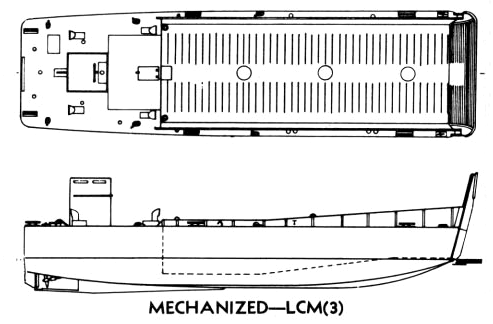
Specs LCM(3)
Displacement: 52 tons (loaded); 23 tons (empty)
Length: 50 feet (15 m)
Beam: 14 feet (4.3 m)
Draft: 3 feet (0.91 m) (forward); 4 feet (1.2 m) (aft)
Powerplant: 2x Detroit 6V-71 diesel 360 hp
Speed: 8 knots (9.2 mph) (loaded); 11 knots (13 mph) (empty)
Armament: two .50-cal M2 Browning HMG
Crew: 4
Capacity: 30-ton medium tank/60 troops/60,000 lb (27,000 kg) cargo
 LCM(6) class (1943)
LCM(6) class (1943)
2,513 built by Higgins industries
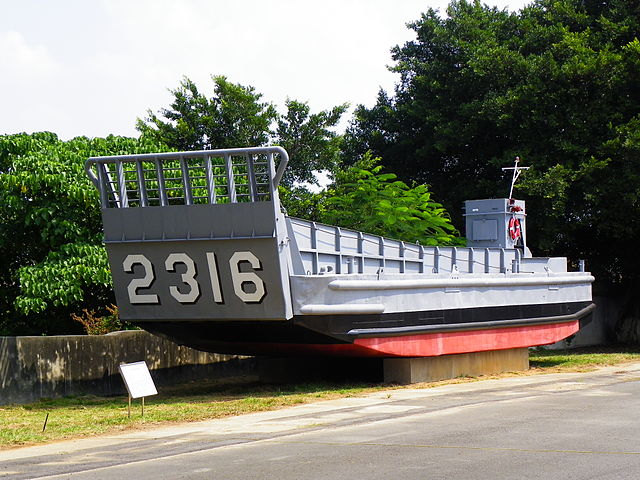
Basically this was an LCM (3) extended by 6 feet (1.8 m) amidships for a longer bay. It was redesigned to carry more troops in addition to the 30 tons Sherman Tank, and needed to be longer as a result, with a longer armoured ramp as well and reworked hull shape for better buoyancy, but with no changes in beam or daught. It was a completely different beast altogether, and that included superstructure, dimensions and displacement, and armament. Like the precious LCM(3) they could take place on the deck of an LST, but carried in modular sections, assembled on site. It was way too heavy to be supported by ships davits, but could fit side inside the LSV, side by side as the width was the same.
Many ended during the 1960s as armoured troop carriers (ATCs or “Tangos”) for the Mobile Riverine Force in Vietnam or “Monitors” with 105mm guns and “Zippos” with flamethrowers, “Charlie” command variants. See the Vietnam War Naval Warfare for more.
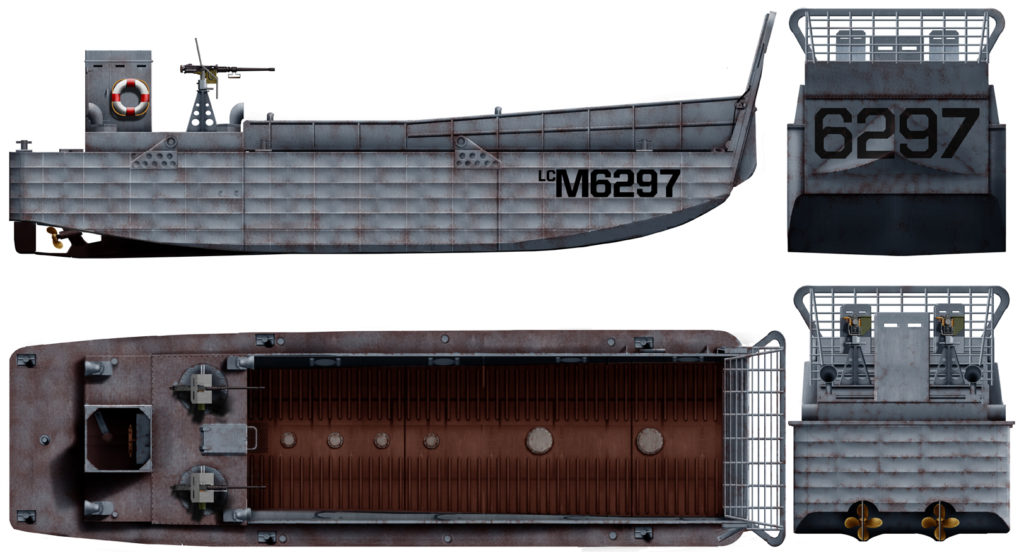
Author’s illustration of the LCM(6)
Specs LCM(6)
Displacement: 64 tons (loaded)
Length: 56.2 feet (17.1 m)
Powerplant: 2x Detroit 6V-71 diesel/8V-71 diesel engines- 360/460 hp
Speed: 9 knots (10.3 mph, 16.6 kph)
Range: 130 miles (240 km) at 9 knots (17 km/h)
Armament: two .50-cal M2 Browning HMG
Crew: 5
Capacity: 30-ton medium tank/80 troops, 34 tons cargo
 LCM(8) class (1959)
LCM(8) class (1959)
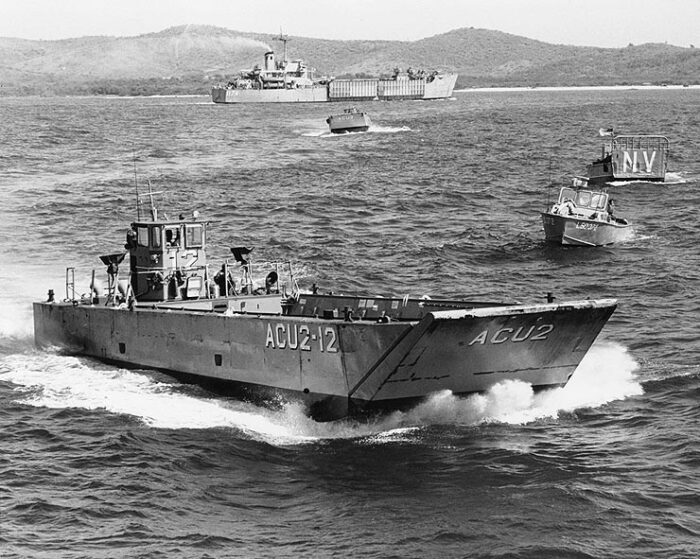
The LCM-8 (“Mike Boat”) was a river boat/mechanized landing craft developed by Marinette Marine Corp. betwen the Korean and Vietnam War. Its nickname mirrored LCM for “Lima Charlie Mike”.
This new craft grew according to new main battle tanks fielded by the US Army, notably the M48 Patton, and was 135,000 pounds (61,200 kg) with a crew of four, with a Boatswain’s Mate petty officer, Engineman petty officer, non-rated fireman and seaman. It was extended to six for a 24-hour combat operations with two coxswains, two seamen and two enginemen. Construction called for welded steel. It was powered by four 6-71 or two 12V71 diesel engines on twin propellers/rudders and boasted a 60 short tons payload. It had a range of 190 miles at 9 knots with a full load.
Vietnam War Variants:
-“Zippo”, modified version with flamethrowers for riverine warfare.
-LCM-8 Mod 2 for command and salvage, in aluminium
-PBR Transport (Da Nang, Tan My Bases and outlying points at Cua Viet and Cua Dai rivers).
-Army Riverine Logistic version (mini-floating drydock).
The LCM(8) remain active until the end of the cold war. It was exported and used by Australia, Cambodia, France, Honduras, India, Laos, Spain, Vietnam, Thailand, Tonga and Turkey. They were used last in Operation Desert Shield/Desrt storm and the 2003 invasion of Iraq. In the 1990s a life extention program was initiated, consisted in the replacement of their oeriginal engines and transmission by a pair of 8v-92 Silver Series Detroit Diesel engines coupled with Allison Hydraulic Transmissions. This was supposed to bring them until the late 2010s.
Discussions for a replacement started, but it was not initiated before the 2000s. This was the Maneuver Support Vessel (Light) or MSV(L). Two dozen were planned as larger and faster variants with longer range, twice the capacity (1x M1 Abrams tank, or 2x Strykers). The hull was to be 100 feet (30 m) long, with a draft of 4 feet, speed 18 knots. Tests were performed in 2019, and Vigor Shipyards was awarded a contract for program completion in 2027. The final order id for 36 boats, a far cry from the thousands LCM(8) that were delivered in the 1960s.
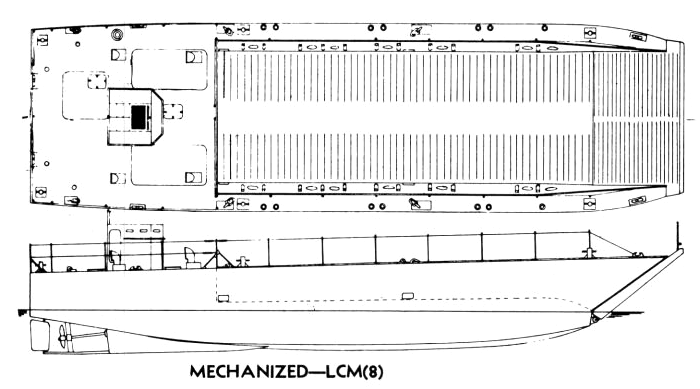
Specs LCM(8)
Displacement: 57.8 long tons light, 111.4 long tons (113.2 t) loaded.
Length: 56.2 feet (17.1 m)
Powerplant: 2x GMC 6-71/Gray Marine 6-71 diesels+ 2 hydrostatic transmissions Detroit 12V-71 diesel
Speed: 12 knots (22 km/h) light, 9 knots (17 km/h) loaded
Range: 190 miles/9 kts
Armament: two .50-cal M2 Browning HMG
Crew: 5
Capacity: M48, M60 MBT or 200 troops, 50 tons cargo
Logistics-Over-The-Shore (LOTS) Operations
Definition. Capability to provide logistical sustainment to early entry forces over an unimproved beach, discharge through ports inaccessible or denied to deep draft shipping, and support of normal fixed port operations made LOTS a very important of amphibious operations in WW2, enabling to exploit a bridgehead. LOTS used the following assets:
LCVP: Built by Andrew J. Higgins Boat Company in April 1943. 36 feet long. Capability of hauling 34 soldiers or one truck.
LCM 6: Landing Craft Mechanized. The hinged bow ramp idea originated in 1926. The LCM was a British design, first prototype came out in 1938. First trials for the Mk1 in February 1940. 45 feet long, designed to transport a 16-ton tank. Higgins experimented it, modified the bow and built the LCM Mk3. The US Army bought also the LCM 6 (also referred to as the Mk4) wit an extra 6-foot section to carry the 30-ton Sherman tank.
Amphibians: DUKW. D (model year), U (amphibian), K (all-wheel drive), W (dual rear axle). Conceived by Rod Stevens, a boat designer and Dick Kerr, a transportation specialist for the Arabian-American Oil Company. P.C. Putman became the project chairman of the national Defense research Committee (NDRC) which became the Office of Strategic Research and Development (OSRD). In 1942, they decided to convert a GMC 2 ½-ton truck to amphibian capability. The pattern was standardized in October 1942. They could land a platoon based on the request “Build me a truck that can swim”. Their immense advantages were to carry payload far inland unlike landing craft, and an easy maintenance and repair due to its commonality with the ubiquitous GMC truck.

Over-the-beach Doctrine:
Engineer Special Brigades (Amphibious Engineers) of the 1st, 5th, and 6th ESBs conducted the landings in North Africa, Mediterranean, and European Theater. The 2nd, 3rd, and 4th ESBs conducted landings in the Pacific Islands. This included 1942 Oran, 3rd Port. 194 Lavita, Sicily. 10th Port., 9 Sep. 43 Salerno and Naples, 6th Port., 23 Jan 44. Anzio. 10th Port., 6 Juned to Sept. 1944 at Omaha Beach with Mulberry A artificial harbor, 11th Port. 15 August 1944 Op. Dragoon in Southern France, 6th Port. 2 Oct. 1944 in Le Harve, 16th Port (German pocket), then Cherbourg Port, with delivery for 28 days by DUKWs until the break wall was rehabilitated 4th Port.
Cold War:
Normandy was remained the lartest LOTS operation of WWII but post-war development focused on how to improve on Normandy. For the next development, the growing size of vehicles and water craft was taken in account. All Engineer Special Brigades were inactivated after WWII, except the 2nd ESB. The latter took part in the landings at Inchon on 15-16 September 1950 and Iwon on 29 October to 8 November 1950.
Doctrine change (1954): The 2nd Engineer Special Brigade was inactivated. The 159th Boat Battalion assumed responsibility for combat landings and LOTS with transportation boat companies conducting landings and terminal operations.
New assets comprised the LCM 8 (from 1955) issued to Co.s A–D, 159th Boat Battalion.
The LCU 1466 (1952) was issued to the 329th Trans Co., 159th Bn.
USAT John U.D. Page. became the largest Army watercraft.
New LOTS Amphibians:
Super DUKW: Competitor of the LARC for the same program, same recipe on hte new M135 truck. XM-147 prototype tested 1953-54, modified and recommended for limited production in 1958, but lost to the LARC.
Lighter Amphibious Resupply Cargo (LARC)-V: 5-ton capacity. The COT MG Paul Yount, directed the US Army Research Command (USATRECOM) in 1956 to build a boat with the ability to drive on land. The prototype was built in July 1959 with final design produced in 1963. Besson, who was COT from 1958 to 1962, was instrumental in their purchase. The LARC V did not handle the way it was expected and they were sent to 35 reserve companies. The active duty 165th, 305th, 344th, 458th, and 461st Trans Co.s had them.
LARC XV (1960): 15-ton capacity development, went no further than the test phase.
BARC/LARC LX (1954). 60-ton capacity. A platoon landing tests was performed at Ft Story, with four BARCs in 1954. 1LT George Hendrickson commanded the platoon, 2LT William Hill was XO. First large scale exercise was SUNEC 55 at Frobisher Bay, Canada. The “Barge Amphibious Resupply Cargo” was nicknamed “Besson’s Ark.” It was also used in Vietnam. Some survived to this day.
Prefabricated ports:
Delong Pier: A British designed, US-built floating causeway was deployed at Omaha Beach but wrecked by the storm of 14 June. Colonel Leon B. DeLong was there, giving him the idea to create a portable pier that could stand up to rough seas. His company constructed the 50 by 250-foot DeLong Piers. The USAF first used it in 1951 to build a runway in Thule in Greenland (Operation BLUE JAY) and 17 Delong piers were son ordered by the US Army.
Aerial Tramway system:
This ide developed by John A. Roeblings’ Sons, Corp. of Trenton, NJ: Two towers connecting a DeLong floating pier to the shore by two track of aerial cable, four cargo cars operating like elevated street cars. First erected by the 577th Aerial Tramway Companyat Little Creek, VA in Operation TRAMTEST, 14-18 November 1955. First stationed at Camp Wallace (Fort Eustis subpost) and moved to Fort Eustis in 1956. Capability to conduct offshore discharge without beach, such as steep cliffs. Summer 1961: The 577th Aerial Tramway Company was declared fully operational, with the 408th and 458th in the Reserves.
Floating Causeway: CONEX, mid 1960s.
These exercises off the northern shore of France were conducted to test new concepts and rehearse for another Normandy like operation in the event the Soviet Union destroyed the fixed ports with nuclear bombs.
Offshore Discharge Exercise (ODEX). Supply-over-the-beach Operations off the Northern Coast of France. Part of the COMZ development in the event the Soviet Union would disable the fixed ports by a nuclear attack. Note that because common use of acronyms the Transportation Corps changed supply over-the-beach to logistics-over-the-shore (LOTS) because soldiers got tired of working on the SOB.
New Offshore Discharge Exercises (NODEX). 1954-1964. DeGualle kicked the US Army out of his country in 1964. 1958 tested the Sky Tram.
LOTS II, Ft Story, VA., 1957.
LOTS Operations:
Operation BLUE JAY, summer 1951. 373rd Transportation Major Port, Thule, Greenland. Construction of the Distance Early Warning (DEW) Line, which stretched from Alaska across the Arctic Circle to Greenland to watch the skies for the feared bomber attack by Russia.
Support Northern Army Command (SUNAC) 1952. 373rd TMP offshore discharge at Thule, Sondrestrom and Narassuak Air Bases Greenland, Labrador and Baffin Island, Canada in support of DEW Line East.
Support Northeastern Command (SUNEC) 1953-65. All landing craft were prepositioned so crews from Ft Eustis deployed to Thule to conduct LOTS to support the DEW Line. The first BARC platoon discharged cargo at Frobisher Bay, Baffin Island, Canada, during SUNEC 55.
Lebanon Crisis, Khalde, near Beirut Airport, 1958.
Vietnam War:
LST Beaches at Cam Ranh Bay and Qui Nhon, 1965-1973. All units arriving in Vietnam were landed by LCMs for ship-to-shore. After the DeLong Piers were established, the LST beaches were used for the discharge of ammunition. For safety reasons, ammunition ships had to remain off shore.
Beach discharge in Mekong Delta (IV Corps Tactical Zone), 1965-1973.
I Corps Tactical Zone. The shallow nature of the beaches in I Corps did not make it practical to build piers, so the resupply was primarily conducted by beach operations. Because of the need for beach support, Military Assistance Command, Vietnam, assigned the US Navy and Marines to this area. In late 1968, the US Army assumed an increasing role in this area.
LOTS at Sau Hugynh, 1967. This LOTS operation conducted by the 159th Terminal Bn supported a brigade of the 101st Abn Div at Duc Pho along the coastal highway. This was conducted by landing craft. Sau Hugynh had a protected shore while the beach at Duc Pho was open ocean subject to rough seas. It was cleared for both LARC LXs and LCUs.
Battle of Hue, 1968. Army LCUs joined Navy YFUs to sail in convoys up the Qua Viet River to Hue and the Perfume River to Dong Ha to deliver supplies. The enemy conducted rolling ambushes along the river. One LCU was destroyed by a command detonated bomb in the water as it passed over. After the Tet Offensive, the US Army established the DaNang Support Command in I CTZ and the Army continued to deliver cargo to Dong Ha and the Navy Ramp at Hue.
LOTS at Wunder Beach, March – September 1968. 159th Terminal Bn. supported the 1st Cavalry Division in its operation to break the siege of Khe Sanh and clear the NVA out of Ashau Valley. This was conducted by LARC Vs and LXs because the beach gradient was too shallow.
LOTS at Vung Ro Bay, 1968. This was conducted by LARC Vs and LXs.
Post Vietnam – Cold War.
LACV 30: 3rd gen. amphibians. SK-5 was used in Vietnam in 1968. Type classified in 1978, in use by 1983. First tested during Offshore Discharge of Container Ship Exercise II (OSDOCII) at Ft Story, VA. It was designed to replace LARCs because its speed improved the time of loading and unloading and its range. Its drawbacks were its costs and 8-hours of routine maintenance.
LCU 1600 (1976)
LCU 2000 (1988) Built by Lockheed Shipbuilding Corp. Thunderbolt, GA. 25 delivered in 1988.
LSV: (1987) Logistical Support Vessel, derived from the USAT John U. D. Page and USAT Bunker.
Containerization: The Joint Review Board directed the development of containers in 1969, with their debut in 1970. Offshore Discharge of Container Ship Exercise (OSDOCI) at Ft Story, VA, in December 1970, tested the ability of helicopters to lift containers off ships.
Read More
Books
J.Gardiner Conway’s all the world’s fighting ships 1922-47, page 162.
Friedman, Norman (2002). U.S. Amphibious Ships and Craft: An Illustrated Design History. Annapolis NIP
Hill, William, “One of those Little-Known Cold War Adventures (And what happened after that)”
Kutta, Timothy J., DUKW in Action, Carrollton, TX: Squadron/Signal Publications, Armor No. 35, 1996.
Ladd, J. D., Assault from the Sea, 1935-1945, NY: Hippocrene Books, Inc., 1976.
Links
https://en.wikipedia.org/wiki/Landing_craft_mechanized
https://www.navy.mil/Resources/Fact-Files/Display-FactFiles/Article/2171588/landing-craft-mechanized-and-utility-lcmlcu/
https://archive.ph/20121212210112/http://www.history.navy.mil/library/online/surfskill.htm
https://web.archive.org/web/20081020030238/http://www.boats.dt.navy.mil/pg2/LCM(6).htm
https://web.archive.org/web/20050527204154/http://www.navy.mil/navydata/fact_display.asp?cid=4200&tid=1600&ct=4
https://web.archive.org/web/20060927172544/http://wrc.navair-rdte.navy.mil/warfighter_enc/SHIPS/shiptype/lcms.htm
https://web.archive.org/web/20060527235410/http://www.ussrankin.org/id40.htm
https://www.combinedops.com/Combined-Operations-601-Landing-Craft-Mechanised-Flotilla-in-WW2.htm
https://web.archive.org/web/20050428200518/http://atiam.train.army.mil/soldierPortal/atia/adlsc/view/public/4837-1/fm/55-50/toc.htm
https://archive.ph/20121212034855/https://savage.nps.edu/Savage/ShipsMilitary/LCM6-LandingCraftMechanized-UnitedStates/_pages/page01.html
https://web.archive.org/web/20090403235455/http://www.battleshipcove.org/exhibits-lcm.htm
https://web.archive.org/web/20081205120723/http://members.lycos.co.uk/Indochine/cefeo/boats.html#LCM1
https://www.facebook.com/profile.php?id=100086543887103
https://www.dday-overlord.com/material/warships/landing-craft/lcm
https://en.wikipedia.org/wiki/Motor_landing_craft
http://pwencycl.kgbudge.com/L/c/LCM_class.htm
Model Kits
3D
https://www.turbosquid.com/3d-models/landingcraft-lcm3-720815
Video

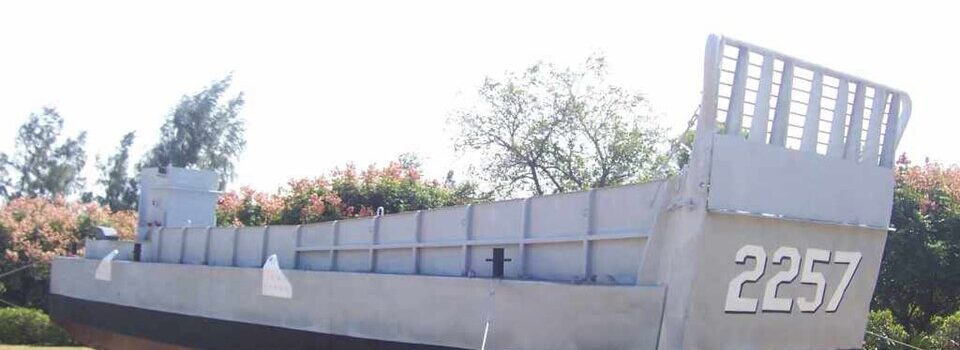
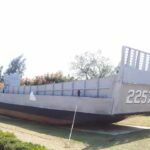


 Latest Facebook Entry -
Latest Facebook Entry -  X(Tweeter) Naval Encyclopedia's deck archive
X(Tweeter) Naval Encyclopedia's deck archive Instagram (@navalencyc)
Instagram (@navalencyc)


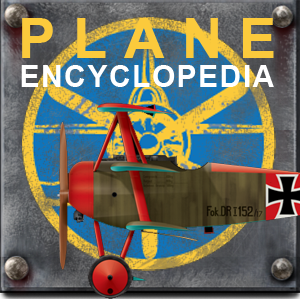
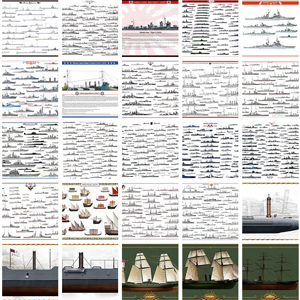

 French Navy
French Navy Royal Navy
Royal Navy Russian Navy
Russian Navy Armada Espanola
Armada Espanola Austrian Navy
Austrian Navy K.u.K. Kriegsmarine
K.u.K. Kriegsmarine Dansk Marine
Dansk Marine Nautiko Hellenon
Nautiko Hellenon Koninklije Marine 1870
Koninklije Marine 1870 Marinha do Brasil
Marinha do Brasil Osmanlı Donanması
Osmanlı Donanması Marina Do Peru
Marina Do Peru Marinha do Portugal
Marinha do Portugal Regia Marina 1870
Regia Marina 1870 Nihhon Kaigun 1870
Nihhon Kaigun 1870 Preußische Marine 1870
Preußische Marine 1870 Russkiy Flot 1870
Russkiy Flot 1870 Svenska marinen
Svenska marinen Søværnet
Søværnet Union Navy
Union Navy Confederate Navy
Confederate Navy Armada de Argentina
Armada de Argentina Imperial Chinese Navy
Imperial Chinese Navy Marinha do Portugal
Marinha do Portugal Mexico
Mexico Kaiserliche Marine
Kaiserliche Marine 1898 US Navy
1898 US Navy Sovietskiy Flot
Sovietskiy Flot Royal Canadian Navy
Royal Canadian Navy Royal Australian Navy
Royal Australian Navy RNZN Fleet
RNZN Fleet Chinese Navy 1937
Chinese Navy 1937 Kriegsmarine
Kriegsmarine Chilean Navy
Chilean Navy Danish Navy
Danish Navy Finnish Navy
Finnish Navy Hellenic Navy
Hellenic Navy Polish Navy
Polish Navy Romanian Navy
Romanian Navy Turkish Navy
Turkish Navy Royal Yugoslav Navy
Royal Yugoslav Navy Royal Thai Navy
Royal Thai Navy Minor Navies
Minor Navies Albania
Albania Austria
Austria Belgium
Belgium Columbia
Columbia Costa Rica
Costa Rica Cuba
Cuba Czechoslovakia
Czechoslovakia Dominican Republic
Dominican Republic Haiti
Haiti Hungary
Hungary Honduras
Honduras Estonia
Estonia Iceland
Iceland Eire
Eire Equador
Equador Iran
Iran Iraq
Iraq Latvia
Latvia Liberia
Liberia Lithuania
Lithuania Mandchukuo
Mandchukuo Morocco
Morocco Nicaragua
Nicaragua Persia
Persia San Salvador
San Salvador Sarawak
Sarawak Uruguay
Uruguay Venezuela
Venezuela Zanzibar
Zanzibar Warsaw Pact Navies
Warsaw Pact Navies Bulgaria
Bulgaria Hungary
Hungary

 Bundesmarine
Bundesmarine Dutch Navy
Dutch Navy Hellenic Navy
Hellenic Navy Marina Militare
Marina Militare Yugoslav Navy
Yugoslav Navy Chinese Navy
Chinese Navy Indian Navy
Indian Navy Indonesian Navy
Indonesian Navy JMSDF
JMSDF North Korean Navy
North Korean Navy Pakistani Navy
Pakistani Navy Philippines Navy
Philippines Navy ROKN
ROKN Rep. of Singapore Navy
Rep. of Singapore Navy Taiwanese Navy
Taiwanese Navy IDF Navy
IDF Navy Saudi Navy
Saudi Navy Royal New Zealand Navy
Royal New Zealand Navy Egyptian Navy
Egyptian Navy South African Navy
South African Navy






























 Ukrainian Navy
Ukrainian Navy dbodesign
dbodesign